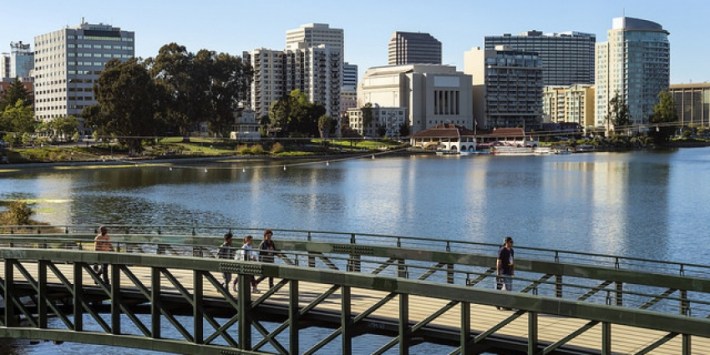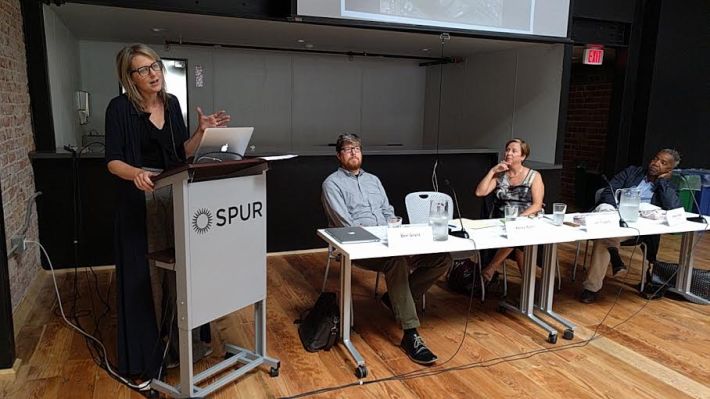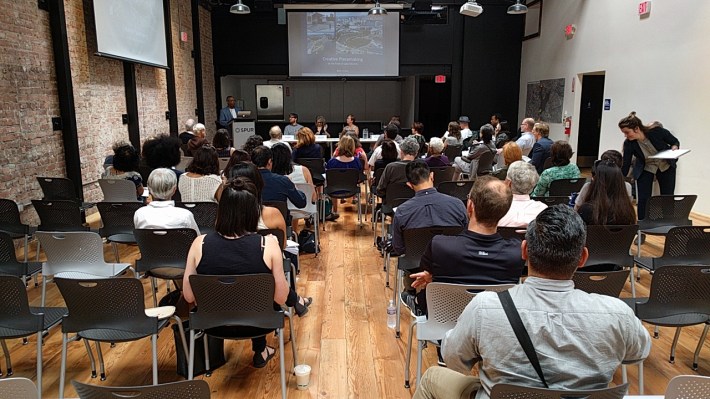
Wednesday afternoon, at SPUR's Oakland office, a crowd of some fifty people came to hear a panel discussion about knitting together the various attractions at the foot of Lake Merritt in Oakland.
At the southern end of Lake Merritt, Oakland's street grid funnels around several big institutions there, including the Oakland Museum of California, Laney College, and the Henry J. Kaiser Convention Center. All are poorly connected to the lake. SPUR is promoting an initiative to connect the whole schmear through art and better pedestrian linkages.
The panel was composed of Lori Fogarty from the Oakland Museum of California, Kelley Kahn from the City of Oakland Department of Economic and Workforce Development, and Walter Hood from the Hood Design Studio. Benjamin Grant, Urban Design Policy Director for SPUR, kicked off the discussion with the definition of "Place Making" from the National Endowment for the Arts:
In creative placemaking, public, private, not-for-profit, and community sectors partner to strategically shape the physical and social character of a neighborhood, town, tribe, city, or region around arts and cultural activities.
From that definition, he gave several examples from other cities of how planners and policy makers can re-activate quiet and often forgotten areas of a city with art. He cited the Pearl Street Project in Philadelphia, the Waterfire Project in Providence, Rhode Island, the Project Row Houses in Houston, Texas, and the Wynwood Walls of Miami, Florida.
All of these are fascinating examples of urban revitalization and Streetsblog readers should check out their websites. But the Wynwood Walls project seemed a particularly good approach for the institutions of Lake Merritt. Miami did a global search and brought urban artists from all over the world to paint the walls of a warehouse district. The effect was to draw people in and create an enlivened and connected urban space. Of course, Lake Merritt is already the home of the Oakland Museum of California, with its walls and multiple levels acting as an urban tableau.

That seemed like something Fogarty, the museum's director, would easily get behind. "The interesting thing about the building is it was envisioned to be integrated with the surrounding neighborhood," she said in her presentation. But given its many blank walls, that hasn't always been the case. "It has brutalist architecture, with a wall around the museum...it can be almost invisible in the surrounding community."
Hood, meanwhile, promoted an evolutionary approach that is guided by community input, instead of allowing engineers to simply come in and redesign things. "When we think about culture and place we need to give it time," he said. Almost on cue, the sound of jackhammers from sidewalk work outside SPUR's Oakland offices momentarily drowned out his presentation. "The change is going on right now!" someone shouted from the audience. He discussed the idea of art for the area that emulates falling water and the estuary. "If the estuary disappeared, we'd all disappear. The estuary is where life begins."
The whole presentation offered much to consider for the community. That said, from Streetsblog's perspective, the main question is about connecting the institutions to the lake rather than to each other, since they are still separated by the lanes of Lake Merritt boulevard. There's also the issue of the bland and confusing plaza at the Lake Merritt BART station, which could definitely use some livening up and better linkages and wayfinding to the institutions (something Oakland is working on) and something the panelists also addressed.
Either way, we can't fault a campaign to add more of a sense of place and general connectivity to this area with its great institutions, all a short walk from transit, the estuary, and a beautiful lake that is already a center of life for the Oakland community. Please tell us your favorite examples of using art to enliven and connect an urban spot.





